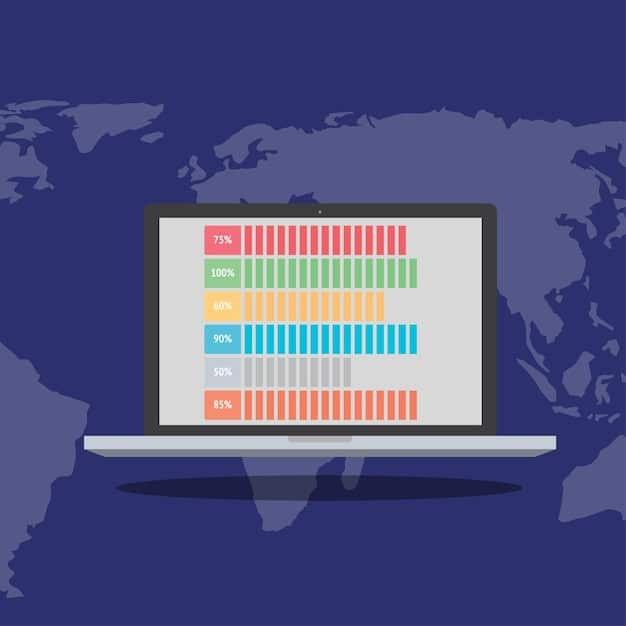Cross-Border Payments: A 2025 Guide for US E-commerce

Cross-border payments for US e-commerce in 2025 will require businesses to navigate currency conversion, international regulations, and emerging technologies like blockchain and AI to provide seamless and cost-effective transactions for global customers, ensuring competitiveness and compliance.
As cross-border payments become increasingly crucial for US e-commerce businesses aiming to expand globally, understanding the nuances of currency conversion and international regulations is paramount for success in 2025, ensuring seamless transactions and competitive advantage.
Understanding the Landscape of Cross-Border E-commerce in 2025
The e-commerce landscape is continually evolving, and by 2025, cross-border payments will be an even more integral part of doing business for US companies. As technology advances and consumer behavior shifts, businesses must adapt their payment strategies to remain competitive in the global market.
Evolving Consumer Expectations
Consumers expect seamless and secure payment experiences, regardless of their location. Meeting these expectations is vital for maintaining customer trust and loyalty. The rise of mobile commerce and the demand for instant gratification further amplify the need for efficient and reliable cross-border payment solutions.
Technological Advancements
New technologies, such as blockchain and AI, are poised to transform the way cross-border payments are processed. These advancements offer opportunities to reduce costs, improve security, and enhance the overall payment experience. Businesses that embrace these technologies will be better positioned to succeed in the global e-commerce market.
- Blockchain Technology: Offers decentralized and secure payment processing, reducing reliance on traditional financial institutions.
- Artificial Intelligence: Helps detect and prevent fraud, ensuring safer transactions.
- Mobile Payment Solutions: Facilitate easier and faster payments for consumers on the go.

In conclusion, understanding the evolving landscape of cross-border e-commerce is essential for US businesses looking to expand their reach in 2025. By focusing on consumer expectations and embracing technological advancements, companies can create payment strategies that drive growth and success in the global market.
Navigating Currency Conversion in Cross-Border Transactions
Currency conversion is a critical aspect of cross-border payments. US e-commerce businesses must understand the complexities involved and implement effective strategies to manage currency exchange rates and associated costs.
Real-Time Exchange Rates
Access to real-time exchange rates is crucial for accurately pricing products and services in different currencies. Many payment gateways and financial institutions offer tools that provide up-to-date exchange rate information, allowing businesses to adjust pricing accordingly.
Currency Hedging Strategies
To mitigate the risks associated with fluctuating exchange rates, businesses can employ currency hedging strategies. These strategies involve using financial instruments, such as forward contracts and options, to lock in exchange rates for future transactions.
- Forward Contracts: Agreements to buy or sell a specific currency at a predetermined exchange rate on a future date.
- Currency Options: Contracts that give the holder the right, but not the obligation, to buy or sell a currency at a specific exchange rate within a specific period.
- Dynamic Currency Conversion (DCC): Allows customers to pay in their home currency, providing transparency and convenience.
Effectively managing currency conversion requires careful planning and the use of appropriate tools and strategies. By understanding the nuances of exchange rates and implementing hedging strategies, US e-commerce businesses can minimize risks and maximize profits in cross-border transactions.
Complying with International Payment Regulations
International payment regulations vary significantly from country to country, making compliance a complex and challenging task for US e-commerce businesses. Understanding and adhering to these regulations is essential for avoiding legal and financial penalties.
Data Privacy and Security
Many countries have strict data privacy and security regulations, such as the General Data Protection Regulation (GDPR) in Europe. These regulations require businesses to protect customer data and ensure that it is processed in accordance with local laws.
Tax Laws and Reporting Requirements
Businesses must comply with the tax laws of the countries in which they operate. This includes collecting and remitting sales tax, VAT, and other applicable taxes. Additionally, businesses may be required to report certain transactions to local tax authorities.

- GDPR Compliance: Protect personal data and obtain consent for data processing.
- PCI DSS Compliance: Secure credit card data and undergo regular security audits.
- Local Tax Laws: Collect and remit applicable taxes in each country.
Compliance with international payment regulations is a critical aspect of cross-border e-commerce. By prioritizing data privacy, adhering to tax laws, and staying informed about regulatory changes, US businesses can minimize risks and ensure long-term success in the global market.
Choosing the Right Payment Gateway for Global E-commerce
Selecting the right payment gateway is crucial for US e-commerce businesses to facilitate cross-border transactions efficiently. The payment gateway acts as an intermediary between the customer and the business, processing payments securely and reliably.
Key Features to Consider
When choosing a payment gateway, businesses should consider factors such as supported currencies, payment methods, security features, and integration capabilities. A robust payment gateway should be able to handle multiple currencies, offer a variety of payment options, and provide advanced fraud protection.
Popular Payment Gateways for Cross-Border E-commerce
Several payment gateways are well-suited for cross-border e-commerce, including PayPal, Stripe, and Worldpay. Each of these gateways offers unique features and benefits, and businesses should carefully evaluate their options to determine which one best meets their needs.
Payment Gateway Integration
Integrating the payment gateway with the e-commerce platform is a critical step. The payment gateway should seamlessly integrate with the existing system to ensure smooth and secure transactions. Many e-commerce platforms offer pre-built integrations with popular payment gateways, simplifying the process.
In summary, choosing the right payment gateway is essential for cross-border success. By carefully evaluating the features, security, and integration capabilities of different payment gateways, US e-commerce businesses can ensure seamless and secure transactions for their global customers.
Optimizing the Customer Payment Experience
Creating a seamless and user-friendly payment experience is vital for attracting and retaining customers in the competitive e-commerce market. An optimized payment experience can significantly impact conversion rates and customer satisfaction.
Localized Payment Options
Offering localized payment options is crucial for catering to the preferences of customers in different countries. This includes supporting popular local payment methods, such as bank transfers, e-wallets, and mobile payment systems.
Transparent Pricing and Fees
Transparency in pricing and fees is essential for building trust with customers. Businesses should clearly display all costs associated with the transaction, including exchange rates, taxes, and any applicable fees. Hidden fees can lead to customer dissatisfaction and cart abandonment.
- Display All Costs Upfront: Ensure customers are aware of all charges before completing the transaction.
- Offer Multiple Payment Options: Provide a variety of payment methods to cater to different customer preferences.
- Provide Secure Checkout: Implement security measures to protect customer data and prevent fraud.
Optimizing the customer payment experience is essential for driving growth and success in cross-border e-commerce. By offering localized payment options, ensuring transparent pricing, and providing a secure checkout process, US businesses can create a positive payment experience for their global customers.
Leveraging Technology for Efficient Cross-Border Payments
Technology plays a crucial role in streamlining cross-border payments and improving efficiency. By leveraging the latest technological advancements, US e-commerce businesses can reduce costs, enhance security, and provide a better payment experience for their customers.
AI and Machine Learning
Artificial intelligence (AI) and machine learning (ML) can be used to detect and prevent fraud, optimize payment routing, and personalize the payment experience. AI-powered systems can analyze transaction data in real-time to identify suspicious activity and prevent fraudulent transactions.
Blockchain Technology
Blockchain technology offers a decentralized and secure platform for processing cross-border payments. Blockchain-based payment systems can reduce transaction costs, improve transparency, and speed up the payment process.
- Fraud Detection: AI algorithms can identify and prevent fraudulent transactions in real-time.
- Payment Routing Optimization: Machine learning can optimize payment routing to reduce costs and improve efficiency.
- Decentralized Transactions: Blockchain technology provides a secure and transparent platform for processing payments.
Leveraging technology is essential for achieving efficiency and competitiveness in cross-border e-commerce. By embracing AI, blockchain, and other technological advancements, US businesses can transform their payment processes and create a better experience for their global customers.
| Key Point | Brief Description |
|---|---|
| 🌍 Global Regulations | Understanding diverse international payment rules |
| 💰 Currency Conversion | Managing exchange rates effectively |
| 🛡️ Payment Gateways | Choosing the right platform for global transactions |
| 🤖 Tech & Innovation | Using AI/Blockchain for Efficiency and Security |
Frequently Asked Questions
▼
Key challenges include currency conversion complexities, varying international regulations, higher transaction fees, and ensuring data security and compliance with different privacy laws.
▼
To comply with GDPR, businesses should obtain explicit consent for data processing, implement robust data protection measures, and provide clear information about data usage to customers.
▼
Payment gateways securely process payments between customers and businesses, handle currency conversions, and ensure compliance with international payment regulations, facilitating smooth cross-border transactions.
▼
AI algorithms analyze transaction data in real-time to detect and prevent fraud, identify suspicious activity, and optimize payment routing, enhancing security and reducing the risk of fraudulent transactions.
▼
Blockchain offers decentralized and secure payment processing, reduces transaction costs, improves transparency, speeds up the payment process, and minimizes reliance on traditional financial institutions.
Conclusion
Navigating the complexities of cross-border payments for US e-commerce businesses in 2025 requires a comprehensive understanding of currency conversion, international regulations, and emerging technologies. By adopting effective strategies and leveraging the latest advancements, businesses can ensure seamless transactions, minimize risks, and achieve success in the global market.





